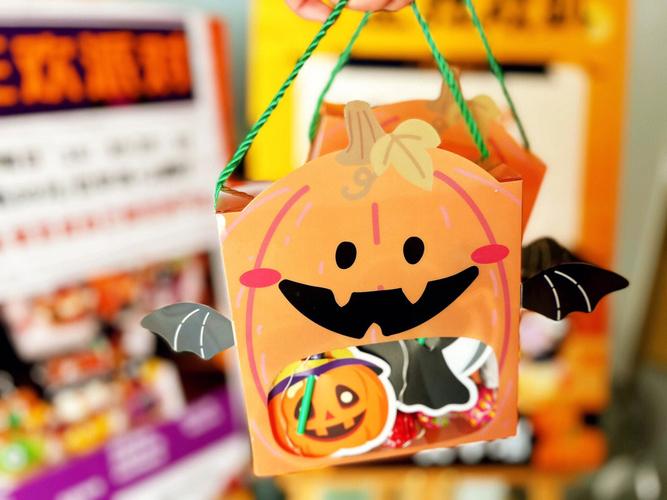万圣节要吃糖果(为什么万圣节要吃糖果)
万圣节要吃糖果(为什么万圣节要吃糖果)
西方人过万圣节,家家户户都要给孩子们准备好充足的糖果,否则可能就要承受捣蛋鬼的恶作剧为什么不是蛋糕、南瓜饼,而是糖果呢?为什么小孩子要在万圣节挨家挨户地讨糖果吃呢?这要从两千多年前的一个节日说起,我来为大家科普一下关于万圣节要吃糖果?下面希望有你要的答案,我们一起来看看吧!

万圣节要吃糖果
西方人过万圣节,家家户户都要给孩子们准备好充足的糖果,否则可能就要承受捣蛋鬼的恶作剧。为什么不是蛋糕、南瓜饼,而是糖果呢?为什么小孩子要在万圣节挨家挨户地讨糖果吃呢?这要从两千多年前的一个节日说起。
Photo by Carl Raw on Unsplash
On October 31, hordes of children armed with Jack-o'-lantern-shaped buckets and pillow cases will take to the streets in search of sugar. Trick-or-treating for candy is synonymous with Halloween, but the tradition had to go through a centuries-long evolution to arrive at the place it is today. So how did the holiday become an opportunity for kids to get free sweets? You can blame pagans, Catholics, and candy companies.
10月31日,成群的孩子们会涌到大街上,带着南瓜形状的篮子和枕套找糖吃。作为万圣节的代名词,“不给糖就捣蛋”这一传统经历了数百年才演变成今天这个样子。那么这个节日是怎么变成孩子们获得免费糖果的机会呢?你可以将其归咎于异教徒、天主教徒和糖果公司。
Historians agree that a Celtic autumn festival called Samhain was the precursor to modern Halloween. Samhain was a time to celebrate the last harvest of the year and the approach of the winter season. It was also a festival for honoring the dead. One way Celtics may have appeased the spirits they believed still walked the Earth was by leaving treats on their doorsteps.
历史学家们一致认为,凯尔特人庆祝秋收的萨温节是现代万圣节的前身。萨温节是庆祝一年中最后一次收获的时节,也是迎接冬天到来的节日。萨温节还是纪念死者的节日。凯尔特人安抚那些依然在世间徘徊的幽灵的方式之一可能就是在自己的门口留下吃食。
precursor[priˈkɜːrsər]: n. 先驱,前导
appease[əˈpiːz]: v. 使满足;安抚,安慰
When Catholics infiltrated Ireland in the 1st century CE, they rebranded many pagan holidays to fit their religion. November 1 became the “feasts of All Saints and All Souls," and the day before it was dubbed "All-Hallows'-Eve." The new holidays looked a lot different from the original Celtic festival, but many traditions stuck around, including the practice of honoring the dead with food. The food of choice for Christians became "soul cakes," small pastries usually baked with expensive ingredients and spices like currants and saffron.
公元1世纪天主教徒入侵爱尔兰时,开始改造许多异教徒的节日,使其适应他们的宗教。11月1日成了万灵节,万灵节前夕被称为“万圣节前夜”。这一新节日和凯尔特人原来的节日大不相同,但凯尔特人的许多传统保留了下来,包括用食物来纪念逝者的行为。基督教徒选择的节日食物被叫作“灵魂蛋糕”,这是一种用昂贵的配料和红醋栗、藏红花等调料烤成的小点心。
Instead of leaving them outside for passing ghosts, soul cakes were distributed to beggars who went door-to-door promising to pray for souls of the deceased in exchange for something to eat. Sometimes they wore costumes to honor the saints—something pagans originally did to avoid being harassed by evil spirits. The ritual, known as souling, is believed to have planted the seeds for modern-day trick-or-treating.
基督教徒没有把“灵魂蛋糕”放在门口供鬼魂享用,而是分发给挨家挨户乞讨的人,这些乞丐承诺为逝者的灵魂祷告,以换取吃食。有时候乞丐们还会穿上纪念圣人的戏服——最初异教徒就是穿上这种服装来避免被恶灵纠缠。据认为,这一名为“索灵”的仪式为现代的“不给糖就捣蛋”埋下了种子。
Photo by Debby Hudson on Unsplash
Souling didn't survive the holiday's migration from Europe to the United States. In America, the first Halloween celebrations were a way to mark the end-of-year harvest season, and the food that was served mainly consisted of homemade seasonal treats like caramel apples and mixed nuts. There were no soul cakes—or candies, for that matter—to be found.
在欧洲的节日向美国迁徙时,“索灵”风俗没有留存下来。在美国,最初的万圣节庆祝活动是为了纪念岁末的收获季节,节日食物主要是自制的应季美食,比如焦糖苹果和什锦坚果。那时候万圣节没有灵魂蛋糕,也没有糖果。
It wasn't until the 1950s that trick-or-treating gained popularity in the US. Following the Great Depression and World War II, the suburbs were booming, and people were looking for excuses to have fun and get to know their neighbors. The old practice of souling was resurrected and made into an excuse for kids to dress up in costumes and roam their neighborhoods. Common trick-or-treat offerings included nuts, coins, and homemade baked goods ("treats" that most kids would turn their noses up at today).
直到20世纪50年代,“不给糖就捣蛋”才在美国风靡起来。大萧条和二战结束后,美国郊区开始繁荣起来,人们想找个由头乐一乐并结识邻居。于是,“索灵”的老习俗就复兴了,并让孩子们有借口化装打扮,在街区游荡。给“捣蛋鬼”准备的东西通常包括坚果、硬币和自制的烘焙食品,今天的大多数孩子恐怕都看不上这些东西。
turn one's nose up at: 对……嗤之以鼻
That changed when the candy companies got their hands on the holiday. They had already convinced consumers that they needed candy on Christmas and Easter, and they were looking for an equally lucrative opportunity to market candy in the fall. The new practice of trick-or-treating was almost too good to be true. Manufacturers downsized candies into smaller, bite-sized packages and began marketing them as treats for Halloween. Adults were grateful to have a convenient alternative to baking, kids loved the sweet treats, and the candy companies made billions.
后来糖果公司把手伸向了这一节日,情况就发生了改变。糖果商已经让消费者相信,他们需要在圣诞节和复活节吃糖果,于是他们开始寻找一个在秋天营销糖果的同样有利可图的良机。“不给糖就捣蛋”的新风俗对他们而言简直是天赐的好运。制造商缩小了糖果包装,将一口一个的小糖果独立包装,并将其作为万圣节款待食品来推销。成年人很庆幸可以买到这么方便的零食而不用再亲手烘焙,孩子们喜欢这些糖果的味道,糖果公司也因此大赚特赚。
Today, it's hard to imagine Halloween without Skittles, chocolate bars, and the perennial candy corn debates. But when you're digging through a bag or bowl of Halloween candy this October, remember that you could have been having eating soul cakes instead.
时至今日,已经难以想象没有彩虹糖、巧克力棒和长年备受争议的玉米糖的万圣节。但是今年十月,当你捧着一袋或一碗万圣节糖果大吃的时候,别忘了你原本可能吃的是“灵魂蛋糕”。
perennial[pəˈreniəl]: adj. 常年的;四季不断的
英文来源:Mental Floss
翻译&编辑:丹妮
来源:中国日报网
-

- 表现友情的诗句有哪些,写朋友深厚友情的诗句
-
2023-07-20 03:58:13
-

- 黄金角蛙寿命(黄金角蛙有毒吗)
-
2023-07-20 03:56:08
-

- 户籍和房产将脱钩,城市难以立足,农村无法回去
-
2023-07-20 03:54:03
-

- 孕早期胎停最明显的4个征兆(你对胎停了解多少)
-
2023-07-20 03:51:59
-

- 一句话总结lpl16支战队现状(有多少人还记得他)
-
2023-07-20 03:49:54
-

- 鬓边不是海棠红陈纫香为什么死(鬓边不是海棠红陈纫香之死)
-
2023-07-20 03:47:49
-

- 山东淄博是几线城市,发展潜力分析
-
2023-07-20 03:45:44
-

- 什么是快铁和高铁有何区别(到底什么是快铁和高铁有何区别)
-
2023-07-20 01:50:36
-

- 儒家文化的核心内容是什么(儒家文化的核心思想)
-
2023-07-20 01:48:32
-

- 樊锦诗简介(樊锦诗简介是什么)
-
2023-07-20 01:46:27
-
- 东厂与西厂的区别(什么是东厂什么是西厂)
-
2023-07-20 01:44:22
-

- 骊歌行剧情介绍(骊歌行剧情介绍讲的是什么)
-
2023-07-20 01:42:17
-

- 心火旺的症状及调理方法(什么是心火旺该怎么调理)
-
2023-07-20 01:40:13
-

- 猫叫是什么征兆(猫叫怎么办)
-
2023-07-20 01:38:08
-

- indesign快捷键是什么(indesign快捷键简述)
-
2023-07-20 01:36:03
-

- 水浒传主题曲歌名叫什么(水浒传主题曲是什么)
-
2023-07-20 01:33:58
-

- 链家司歌歌词(链家司歌歌词是什么)
-
2023-07-20 01:31:53
-

- 为什么高考时间要定在6月7号和8号(高考时间为什么定在7月7日)
-
2023-07-19 17:22:27
-

- 七小福分别是谁都叫什么(是谁创造了七小福)
-
2023-07-19 17:20:22
-

- 战地2042为什么启动失败 战地2042beta公测unknownerror无法开始游戏解决办
-
2023-07-19 17:18:17





 地铁线路图昆明5号线(5号线来了快上车)
地铁线路图昆明5号线(5号线来了快上车) 安踏特步多少亿(安踏特步361度的老板为什么都姓丁)
安踏特步多少亿(安踏特步361度的老板为什么都姓丁)